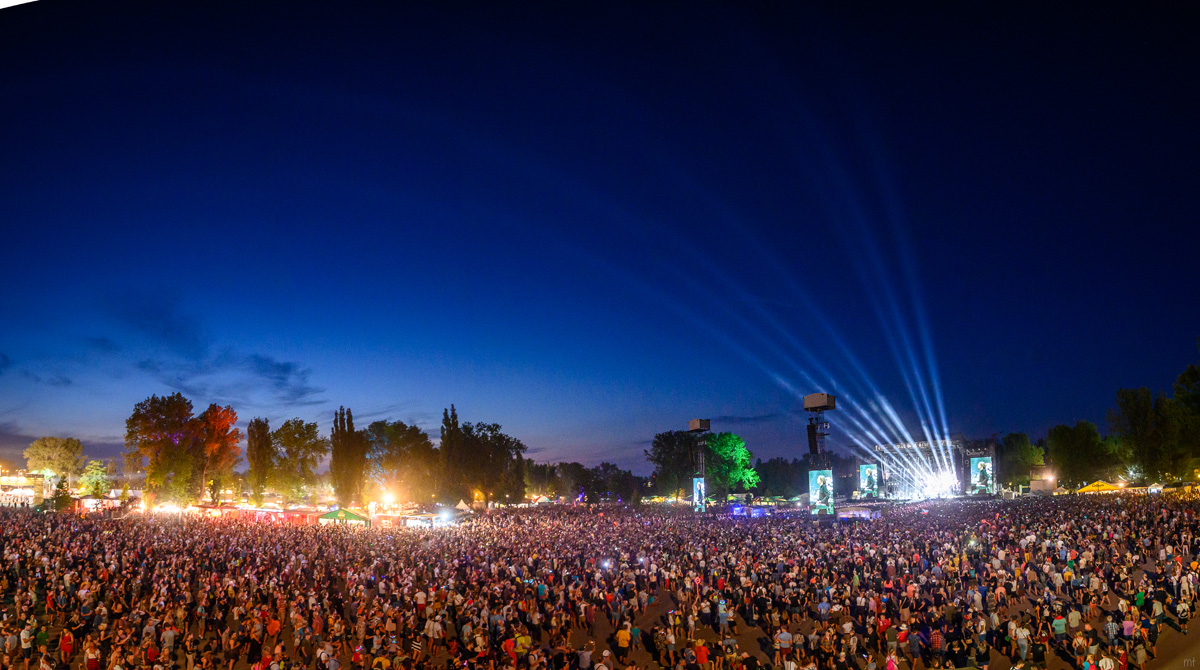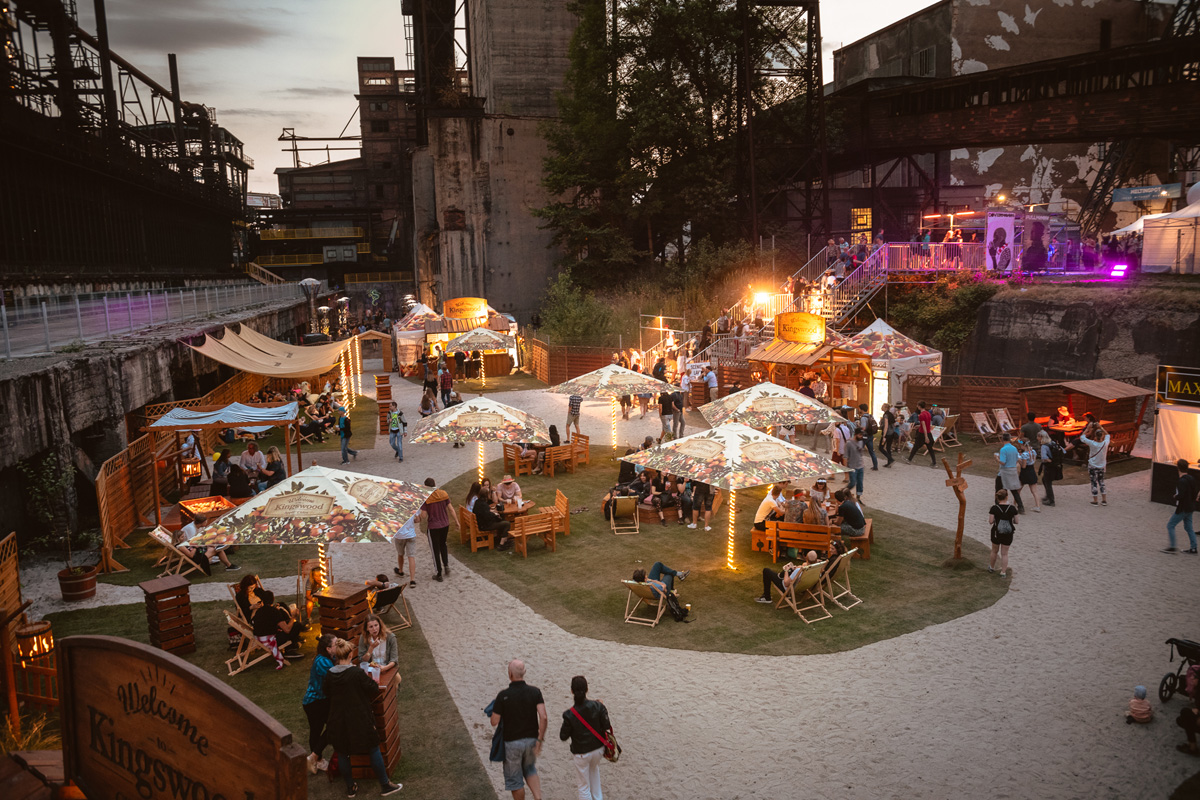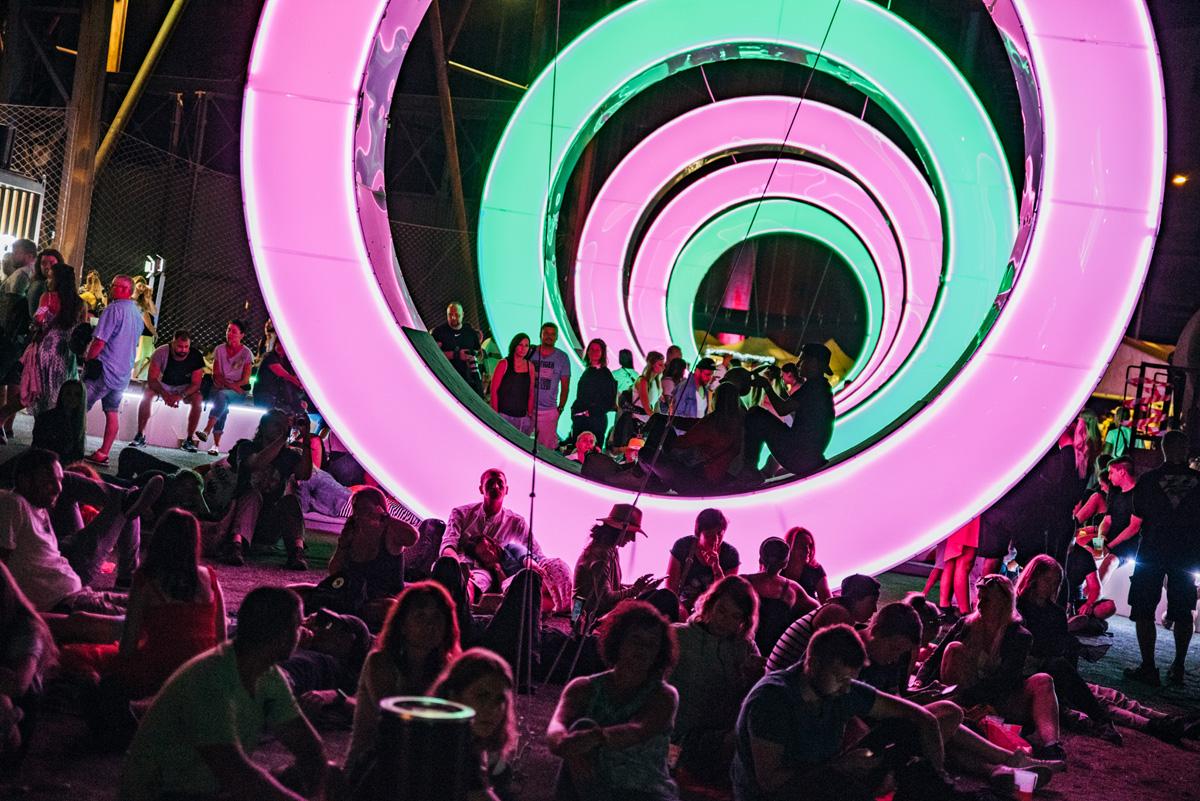The Czech festival Colours of Ostrava is merging together with its city. The location, an old steel and coal factory, is once a year blooming in full colour and creates an interplay of the places history, music, arts and culture.
text Isabel Roudsarabi
redaktion Robin Hartmann
fotos Matěj Rumpa, Eva Dang, Michal Lukáč, Petr Piechowicz, Čestmír Jíra, Matyáš Theuer, Michal Augustini, Zdenko Hanout, Ivan Prokop
reading time 11 minutes
The festival has become an institution in the Czech festivallandscape. Every year it brings headliner like The Killers, Jamie Cullum oder Imagine Dragons in the former industrial city of Ostrava.
Additionally to the broad music program, visitors have a million of possibilities to for example learn about the culture of the region, inform themselves about the history of the location, visit discussions about politics or science or play with their kids in the family-friendly part of the festival.
At Eurosonic 2020, we talked to press manager Jiří Sedlák, who told us why the former black heart of the Czech Republic is now full of colour and why the side program is a crucial part of the event.
Hey Jiri! Can you tell us about your position at the festival and how you came to working for Colours of Ostrava?
I have been working for Colours of Ostrava for 17 years, since the second year of the festival - so I saw the festival grow from a local art and music festival to what it is today. We began trying to not only focus on World music, but also other genres and I accompanied its growth until it became one of the biggest festivals in the Czech Republic. During all this time I have been doing communication, PR, promotion and everything involved. These are my personal concerns, however, I do of course love the music we present. In the beginning of Colours of Ostrava there were some really great local and Balkan bands which were being booked at the time, which I loved, so when they approached me asking to start working for them all I could say was: "Yes, yes - of course!" *laughs*
Today, Colours of Ostrava has become the most important job for me.
So they asked you to do the promotion, just like that, 17 years ago?
It happened through a mutual friend. He recommended me and my colleague to a PR agency from Prague, saying how we should join them because Colors of Ostrava was dependent on good and working PR in Prague, because that's where all the national organisers, media partners and commercial partners are based. Ostrava needed to expand its local focus, since it is quite far from the capital, as you've maybe seen on the map. Ostrava is off to the East and used to be the black heart of the Czech Republic in terms of its steel, iron and coal industry. So the concept of "Colours" was created because Ostrava was not that appealing to people from the Republic at the time. We had a saying that went:
Ostrava is not dark any more, it's now colourful.
The concept then became a reality and the people of the Czech Republic are now really fond of Ostrava, because it has such an interesting history, even the region - which was really rough and polluted a few decades ago - but nowadays developed into a creative centre of the country. And I think Colours of Ostrava is part of that story and evolution.
Your festival site is very beautiful and has a very unique character to it. Can you tell me more about its history and how it developed into what it is today?
Sure. It's a place where coal and steel mining and productions co-existed together. The proximity of both branches to each other is an advantage in the industry because for steel production you need coal etc. I am not an expert, but the tower was one of the centres of steel and iron production until very recently, 1998 maybe, I am not entirely sure.
But when production was stopped the owners of the company, factory and area had the idea not to tear the buildings down, but to turn them into cultural, scientific and technological centres. So back then the city council, regional council and the landlords began some kind of joint venture outlining the design of the area you see there today. Colours of Ostrava itself has been part of this cultural site since 2012, I believe. We were the first big event taking place in this specific area; beforehand we used to be situated in the very centre of Ostrava around a few parks and exhibition grounds. However, at some point the owner of the factory approached us saying: "Why don't you move here, it's a great venue?"
You have open air venues for 20.000 - 30.000 people for huge events; there are smaller venues; there are also venues with a closed roof for maybe 200 people, where you can have panels and discussions or a small club concert.
There's also a very special one called "Gong Hall", which used to be a gas reservoir and has now turned into a congress and concert hall.
It's huge - it holds about 1.500 people. And it's perfect for Jazz or World music concerts. We even had Tindersticks playing there once.
I think except for Black Metal, Hardcore or Hip-Hop we usually try to book and adequately facilitate all the different genres you could think of. We try not to narrow it down to one specific genre of music we support.
How did the festival develop over the years?
It started out as a World music festival because the director used to be a radio journalist, so she preferred presenting World music in the beginning. She looked up to Rudolstadt Festival in Germany, which was another city festival with many venues spread around town. We had several indoor venues and one or two open air stages in the park. But in the second year already the idea developed to have more than one genre represented at the festival, like Rock and Pop.
Nowadays it's 24 stages, 9 of which are our so-called "Melting Pot Forum" consisting of discussion stages for science, technology as well as cultural, spiritual and musical forms.
I actually wanted to ask you about that because I saw you had a huge side program. How did it come about and why is it important to you?
We always had one or two discussion stages and workshops where visitors could learn things like Salsa, Flamenco, African dances or drumming. So the idea has always been there and was very important to us.
I don't want to say we were smarter than everyone else back then, but we were certainly very open-minded and wanted to incorporate new platforms into our festival program.
We want people to educate themselves, interact and learn something new
- even when it comes to maybe listening to music they don't know or music that might not be their favourite genre. So we held open discussions in which you could participate if you were interested, and the attendance turned out to be quite high.
I think five years ago our director got the idea to really expand the whole discussion and workshop platform. Instead of 1-2 stages dedicated to this we then had 8. Since it all went so well and was well received, she started to get really fond of the idea of having these forums, so the Melting Pot Forum has now become one of her main interests. So far, we are really proud of having attracted people like Timothy Snyder and many other guests to give lectures here.
It has become part of the area, with its own distinct identity.
Usually, once the workshops and panels are over, these Melting Pot venues turn into clubs or party areas at night.
I also feel like the visitors are getting more interested in these kind of alternative festival experiences. They expect more. They don't just want to be entertained with music, they want to engage with a cultural program, maybe even the political landscape of the area... so does become creating a festival more demanding under these circumstances?
Yeah, that's true. I think you can also observe that festival audiences tend to become a bit older, like in between 25 - 35 on average. Which for us brings the challenge of including some family-friendly activities, too. I think the days of festivals being a hub for drunk people are somewhat over. *laughs*
Festivals used to carry this image of drunk audiences, fights and just some unpleasant behaviour. At Colours of Ostrava we try to encourage a very peaceful atmosphere, very open-minded.
What was your favourite act that played Colours of Ostrava so far?
Tricky question - way too many. Because that's the core idea; we are trying to book bands we like ourselves and of which we know they are exciting to see in a live setting. That's why - for example - many of our bookers are here [in Groningen] now to see some of these acts beforehand and really filter our booking according to live performances instead of just watching their YouTube videos etc.
Some of my favourites so far were Florence And The Machine, Woodkid and Sigur Rós and there's several bands which names we really established in the Czech Republic like French singer ZAZ, LP or Jamie Cullum. Three years ago was one of my favourites, though; we had Jamiroquai, Norah Jones, Imagine Dragons, Midnight Oil and LP all in the same year and it was sold out for the first time in the new location.
And how many people are coming to visit you every year?
We usually don't publicly proclaim our numbers, but it's somewhere between 40.000 to 50.000 people. It's not a boutique festival any more, at least not in terms of size. But it grew really organically, so I hope people like to come back to our festival because they feel like they're treated well and are taken care of. In our experience what our visitors usually say is: "Okay, I didn't know most of the names on the line-up but now I am a fan".
Did you feel like you made the audience change their habits when you adjusted your booking and program? Did you have to break barriers or have they always been that open-minded?
I think the audience grew with us. In the beginning we couldn't really attract such a huge audience.
I think one of the main reasons people attend any festival in general is that they get recommendations from friends. So if they've had a good experience, they want others to come with them. I don't feel comfortable to say we educated or schooled our audience in any way - they still like to party, too - but we have our ideas of course and in the end it's some kind of mixture. And I think it's quite an advantage that Ostrova is far off, so we have lots of people travelling here from the big cities. We can provide this holiday feeling for them and also learn from them.
I think something that differentiates us from other festivals in the Czech Republic is that our posters only promote international acts and names, whereas the other 90% - except maybe a few exceptions -, they book and promote mostly Czech bands and the line-ups around the country are usually pretty similar to each other. I'm not saying that's bad per se; it's simply a different way of organising a festival.
Another part of our story is that Ostrava of course used to be home to many former miners and steel workers, so by presenting an alternative to maybe Hard Rock or Metal, which might be the favourites of these people, we are able to attract a broader spectrum. So Colours of Ostrava really became a part of the identity of Ostrava because our cooperation with the city is very close. When you ask people about Ostrava now, some of the first things they will say is: "Colours of Ostrava! I know that festival, even though I was never there." I think that's something really precious.
Many governing bodies of cities where festivals take place are not too happy about it because it tends to get dirty and loud, and they might experience resident complaints. So I think it's a huge deal for a city to be involved in creating this festival in such a positive way.
Yes, I think that's because everyone realises it's a great way to promote the city of Ostrava and the region. I mean, the name of the city is in the name of the festival. Maybe you even saw the Ostrava city logo; it has got three exclamation marks: "Ostrava!!!". So Ostrava is a very proud city and self-identifying with a vision of progress. That's why the relationship with the festival works so well. Of course, we need to obey regulations regarding noise at night, since we are only three tram stops away from the city centre. So in reverse, we offer a program called "Colours Plus" that offers either free or reduced entry and discounts to city sightseeing and museums etc.
You can spend your day exploring an old mine, attend arts exhibitions or cafe's and come back in the afternoon to see music.
We are part of the landscape here and we closely cooperate with all the regional tourist offices.
Sounds like you're almost merging into the cityscape.
Yeah, we are trying. *laughs*
My impression really is that, of course, local businesses make good revenue from some of the tourists the festival attracts. There might be local residents downtown saying they don't like all the tourists in the festival season coming here, but they still appreciate the attraction and charisma the festival brings to Ostrava. It's great advertisement, but of course very busy. The hotels for example are completely packed.
Is there still things your want to change about the festival in the near future? Are there any new paths you want to explore?
I think so, yeah. We mostly want to focus on the practical side of things, though - like accommodation. We have camping as well, of course, but the prizes for accommodation in the city are skyrocketing each year during the week of the festival so it becomes really expensive to stay here if you decide to book last minute.
Regarding sustainability: the path of good will is the one we want to go. That means we're slowly implementing new things; last year it we replaced plastic straws, for example. Then we have an important "without barriers" program for disabled people who can seek assistance for free and gain accesibility to every venue by services driving or accompanying them. We're also trying to become more family-friendly.
Generally, we would like to head into a direction where we become of a festival with lots of art installations. The surrounding area with all its structures is already art in itself, but we would like to complement that with visual arts.
Would you consider yourself a political festival in any kind of way? Because you have a lasting social relevance for the region and its people, it seems. Do you have any political programs?
No. We are trying to be not political. With our program, of course, we are supporting openness and the diversity is music, art, culture and science in a variety of topics to pay respect to many different groups of people. As I said before, some people come here to party, some to visit The Melting Pot. We try to carry out an open-mindedness toward ideas from all around the world, but we don't proclaim open political statements.
Can you tell me a little bit about your team? Who's working with you and how many people are you?
During the festival we have about 4.000 people working for us including security, volunteers and so on. During most parts of the year, however, our key team consists of 9 people in management, and maybe 20 to 30 people in the broader spectrum. We have two main offices. The main one in Ostrava, but also another one in Prague. I, for example, was based in Prague from the beginning.
But yeah, the core of people is maybe 20 - 25. However, some of the close people are freelancers so they're taking on other jobs during the off-season as well like stage direction, event management and so on.
For somebody visiting Ostrava this year, what would you recommend they'd have to see or do at the festival that's unlike anything else?
I think the first thing you would need to to is just walk the festival area.
Somebody once said it's like an unreal city from a Jules Verne book.
You can have a guided tour up the black furnace tower, it's pretty amazing.
The second impression would be of the line-up and acts. I think we have an especially great crowd that's always dedicated to the bands playing. Many bands tell us so - maybe they do to every festival. *laughs*
So if you want to enjoy the music in full, with a great sound and stages equipped with the latest technology and in a very peaceful environment, very family-oriented with people immersing themselves, you are right here.
And - that's maybe interesting to people travelling from Western Europe - we are a bit cheaper than what you're used to.
We sell beer for 1€ or 1,50€ - a big one, too.
That's a minor advantage, of course. But mostly the feedback from our international audience is that they want to return.
Right now, for 2020, we have announced some of our headliners, for example we've got Twenty One Pilots, The Lumineers, Tindersticks, Sigrid...
Is there anything else you really want people to know about the festival?
Just come and you will be surprised. You will enjoy the stay in terms of music and atmosphere of the industrial area.













